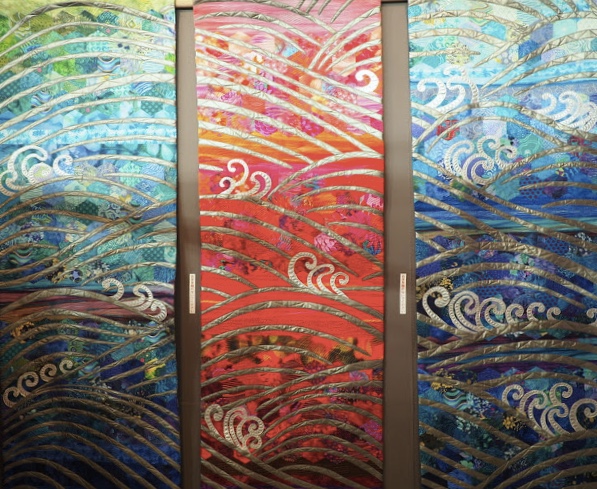This will probably be the last report from the show.
We are looking at the professionals' quilts. 'Sensei' is the title for masters or teachers or other pros whom you look up to. Many of the Japanese quilt 'senseis' specialize in only
one type of quilt and have honed their skills and never venture into another style of quilting.
In the last blog post we looked at a quilt with Cathedral Windows and how it had inspired Julie, Tanya and self into taking on the challenge of trying out that style for next year.
We got even more inspiration when we saw
EIKO OKANO's (岡野栄子)fantastic Cathedral Window kimono quilt. It is called
Edo Kiriko, which is the cut glass of Tokyo.


As far as I know this is the first CW quilt Ms Okano has made, but she has made many quilts in the shape of a kimono and almost all her quilts feature a mass of small buttons.
In my opinion this quilt was one of the best at the show.
A 'sensei' who is highly commended for her PERFECT appliqué is KEIKO MIYAUCHI (宮内恵子)
She is also very colour confident and there is always both contrast and gradation in her work.
MACHIKO MIYATANI's (宮谷真知子) genre is Crazy Quilting, but very 'sane' or controlled such.
If I have got it right Ms Miyatani comes from a tailoring family and have probably learned how to cut, insert pieces and stitch with precision.

This year she showed a unique quilt. The pattern is that of
Ainu the indigenous people of Japan. The pattern had been painted on the fabric (I think!), and then stitched and embroidered.
Julie was instantly drawn to this design as she is planning to work the lining of her Mola waist coat with Ainu designs to make it a reversible garment.
NORIKO MASUI's (升井紀子) style is Medallion Quilts. Her hallmark? Fussy cutting of fabric, balancing the colour palette and precise stitching.


I am drawn to her quilts with magnetic force!
YOSHIKO KURIHARA (栗原淑子) won the Grand Prix one year and has since then produced one quilt after another with geometric people. Here are people in Tokyo in summer.

NAOKO TAKESHITA (竹下直子) calls her creation 'In The Kimono Chest of Drawers...' so I guess this quilt is made from recycled kimono fabric, although it doesn't look it. There is no question about the attention to details and high level of craftsmanship, though.
Don't you think blue and brown, light blue and cream make such a beautiful combination?




Someone who HAS used kimono scraps for her quilt is TAEKO SHINOZAKI (篠崎妙子)

Scraps of kimono were used for this quilt, too, by MICHIKO SONOBE (園部美知子)

HIROKO KOIKE (古池裕子) is another stitcher with skills extraordinaire.

There is always a crowd around YOKO SEKITA's (関田陽子) amusing quilts. So many details, so much of Japanese culture, such skill at handling the tricky kimono silk for the tiny appliqué as well as the charming and humorous scene.

Here is The Foxs wedding. The poor bride in her white kimono sits forlornly and angrily by the sake cup (used for the wedding vows) while the bridegroom has fallen asleep in a drunken stupor together with the matchmaker whose wife is trying to tug him awake.


Ms Sekita loves Alice in Wonderland, and has invited Alice and the Mad Hatter as wedding guests. Alice is tangled up in a kimono with a mask in front of her face.
These quilts are a bit like Where's Wally? and visitors flock around Ms Sekita's quilts to look for Alice.
JUNKO SAWADA (沢田淳子) celebrates Japanese architecture, the tea room with its kettle, paper window and flower arrangement on the wall.

In the garden, there is raked sand, and islands of rock, like the famous
Ryoanji garden in Kyoto.

Kimono fabric mixed with quilters cotton, and then machine stitched.

MITSUYO AKITA (秋田光代) made a quilt with two men dancing the Lion Dance.

The expression
BORO for quilts made of rags has inspired quilters to make use of every little piece of fabric there is in some way or other.
KIYOKO HARADA (原田清子) used the red silk rags in her stash with a sprinkling of gold and green and ....

Silk waste, odd strings, beads and sequins also found a home here.

The ultimate ragged quilt was this blue and brown one by
SATOKO OKAMURA (岡村智子)

Look at the quilting! I have never seen anything like this - laced quilting in variegated thread!
With such fraying edges on the patches you do need tight netlike quilting, though.
Here, however, is a three-paneled quilt by YOKO UEDA (上田陽子) that is made entirely of new fabric, it is beautifully shaded and accented with metallic waves. The setting sun on waves!
I hope you have enjoyed this quilt show as much as I have. Seeing the quilts in person, and with persons you like, can't be beaten. Hope to see you at the show next year!
Julie, Tanya and Pamela. Thank you!
Finally I would like to share with you a few photos of the antique quilts in Ms Takako Onoyama's collection. Do you remember? She is the lady who opened the first quilt shop in Japan, Quilt House Yama. I wrote about it
here.


Look at this! Isn't it a lovely crazy quilt?
There is a special reason why I added these three photos as the last of my visit to Tokyo International Great Quilt Festival 2018. More about that in my NEXT blogpost!





































































